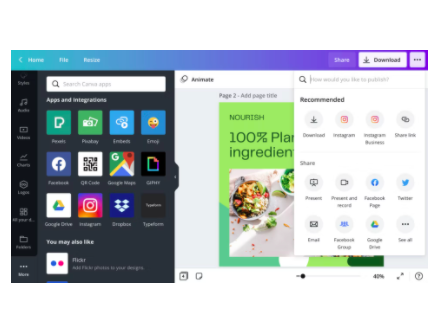Social media marketing can help you attract new customers and grow a loyal customer base. Here’s how you can leverage social platforms to grow your business.
Social media has changed the way we communicate. The question small-business owners ask is no longer, “Should I use social media to promote my business?” but rather, “How should I use social media to promote my business?”
As a small-business owner, your time is a valuable and finite commodity. You don’t have the time to spend all day navigating a dozen social media platforms or the resources to hire a social media specialist to do it for you.
Marketing experts, social media specialists, and small-business owners understand these limitations and have ways to work with them instead of against them.
Their advice is clear: When you invest in strategic social media marketing, your small business will see increased traffic, better brand awareness, and healthier customer satisfaction. Here’s how experts set goals and develop strategies to get the most out of their social media presence.
1. Schedule beyond the 9-to-5
There never seems to be enough time in the day (or workweek) to get everything done. This is where automation is your friend: You can schedule your social media content instead of posting on each platform manually.
Christina Hager, head of social media strategy and distribution at Overflow Storytelling Lab, likes to schedule social media activities ahead of time.
Once you’ve developed your strategy and you know your campaigns, you can create your content early. This way, you will be able to see where everything goes.


Christina Hager
Social Media Strategy and Distribution, Overflow Storytelling Lab
By scheduling ahead, you can plan campaigns and posts so that they create a cohesive narrative and work together to communicate your business’s message. Hagar recommends creating an editorial calendar to keep track of posts and themes, hiring a marketing intern if it’s within budget, and using a scheduling tool.
Create an editorial calendar to track what you post
An editorial calendar will help you keep track of original and curated content in one place. It also allows for easy updating and collaboration, which is key if you share social media responsibilities across your team. This will also make sure you’re not accidentally repeating or forgetting post content.
Hire an intern or marketing student to do your posting
Devote your time to develop a strategy, then hire someone with experience and enthusiasm for social media to do the posting, create extra content, and contribute to campaign ideations.
Use a scheduling tool
Hager uses social media management software to schedule posts and advises her clients to do the same. “It is a huge timesaver,” she explained. “You can block out time and get your entire week (or month)--done.”
pro tip
If you schedule your social media ahead of time, keep an eye on current events. In the wake of a natural disaster or another catastrophe, allowing previously scheduled content to go through before acknowledging the event could come across as insensitive. Luckily, most scheduling tools make it easy to see all upcoming posts and cancel them if necessary.

Content scheduling in Hootsuite (Source)
2. Customize for your target audience
An engaging social media presence isn’t just about how often you post. As Hager points out, what you post is just as important, if not more so.
Without a strategy and a specific audience to target, your social media efforts will be spread too thin across a sea of content.
Instead, Hager says, focus on your target audience, and build up a social media presence that seeks them out and speaks their language. Find out where your target demographic is, and then utilize social media data; check out reports by Hootsuite to find out which platform they are most active on.
For example, if your small business sells handmade baby clothes, your energy is best spent sharing information and tips that build value and trust with new, busy moms. Or, if you are trying to market gear for adventurous travelers, think about that demographic, and make your content, copy, and images speak to them.
pro tip
Be sure to use the excellent detail targeting capabilities Facebook offers. You can target specific behaviors or interests, even down to individual job titles. Understanding who your audience is and what they are interested in will help you develop content useful to them. Social media marketing platforms often have social listening capabilities that allow you to track audience demographics and how they interact with your content.

Social listening on Sprout Social (Source)
3. Cut through the social media noise
Once you’ve identified your target audience, how do you cut through all the social media noise and catch the eye of a potential customer?
Facebook had 2.23 billion monthly active users as of the second quarter of 2018—how can one small business ever hope to break through that kind of traffic and find their potential customers?
Dean DeCarlo, president of Mission Disrupt, an advertising/marketing company, said that authentic content makes a social media strategy more likely to succeed.
Companies should focus on coming up with original content centered around the community they represent.


Dean DeCarlo
President of Mission Disrupt
Success when it comes to social media is often measured in terms of views, likes and comments, and shares. With social media content, you have an ongoing choice to share content you curate from other creators or original content. DeCarlos said that his team sees more engagement when they create their own video content. They produce weekly videos on marketing tips as well as how-tos for marketers, which gives them a platform to spread thought leadership and best practices.
pro tip
As a small business, you have the advantage of a close, direct relationship with your customers. Use Facebook Live video and Instagram Stories to provide updates and communicate with your customers and community. Remember that to create effective content, you don’t need to be a professional designer or video editor: There are affordable graphic designer platforms and video editing tools that can even help novices create works of art.

Canva allows users to either create designs from scratch or from templates and download them for specific social media platforms (Source)
4. Leverage your community
As DeCarlo pointed out, the key to ensuring that your content has reach and engagement is a focus on the community you’re trying to engage.
Whether that community is geographic or topical, if a business is not first and foremost focused on the community surrounding them, they are missing a key opportunity to positively influence how a potential customer perceives their product or service.
DeCarlo points to the auto industry as an example—let’s say you are the CEO of a local car dealership. “Instead of posting about promotions or photos from around the office, I would instead decide to dedicate my account to showing off exciting, luxury cars.”
This entices both the topical community of devout car enthusiasts, and the rest of us who can at least appreciate a photo of a sleek Porsche.
If you’re a brick-and-mortar retail boutique, you can leverage your community geographically. Try engaging on profiles using your city’s location tag to get people aware of your presence in their city.
pro tip
Respond to comments rapidly–within 24 hours or less–and create stories that get people excited to participate. Leverage local events and topics trending within your community. If you’re worried this could become overwhelming, look for a social media marketing tool that will put all social media comments and messages into one place to streamline responding.

Social media inbox in AgoraPulse (Source)
5. Measure what you can act on
With these solid methodologies in place, the last question to ask is this: Did it work? How can you track and measure the effectiveness of your social media activity?
Nathalie Couet, communications, marketing, and partnerships manager at Dashthis.com, said it’s important to learn how to separate vanity metrics from metrics you can act on. A stat that looks good but is not actionable (such as number of likes on a post), is a vanity metric.
Couet and other marketing experts measure things such as:
Engagement in terms of followers
Number of likes
Number of shares or retweets
Number of comments
The important difference between followers/subscribers and likes on a specific post is that followers and subscribers are knowingly asking for more of your content in their lives.
It’s also important to give yourself goals and benchmarks.
Just saying I want to increase my followers neither holds you accountable, explains Couet, nor does it give you specific methods with which to reach that goal. Instead, say something like: ‘I want to double my number of followers in the next 12 months, which I will do by posting content twice a month, boosting one post per month to my target audience, thus increasing followers X% each month.'


Nathalie Couet
Communications, Marketing, and Partnerships Manager, Dashthis.com
This gives you something concrete to hold onto and allows you to see if you’re going in the right direction, or if your goals and methods need adjusting.
pro tip
Social media marketing software can help you take your analytics to the next level. Check out Capterra’s Top 20 Report for all the information you need on the best social media marketing software.
Happy customers are loyal customers
As your social media presence grows, it will present you with opportunities to interact with your customers directly. Take this chance to delight your customer with personal attention and responsiveness.
Zach Hendrix, co-founder of GreenPal, worked with his team to see what this business’s social media presence was missing. They asked themselves, “how do we inject some personality into our social media marketing campaigns to evoke a personal connection with our customer?”
After brainstorming, they came up with an idea that would allow them to leave a lasting and delightful impression on their customers. They did it through pets.
“When a homeowner signs up for our service,” Hendrix explained, “we ask them if there are pets in the home so our lawn vendors know to be careful.”
Hendrix and his team at GreenPal decided this was a golden opportunity to wow their customers by sending a personalized gift to their customers’ pet, addressed specifically to the animal.
“We received personal thank-you notes, videos of their dog chewing the bone we sent posted to Facebook, and thank you tweets,” Hendrix said. “It worked really well for the time and money we invested.”
A happy customer is your best ambassador in the social media sphere. When you receive glowing feedback from a client, ask them to share their experience publicly on Yelp, Google Reviews, or even directly on your website.
Depending on your needs, you can hire an agency for help with your social media marketing. Check out our hiring guides for social media marketing agencies and full service digital agencies to determine which one would be a better fit for you.
Further reading:
